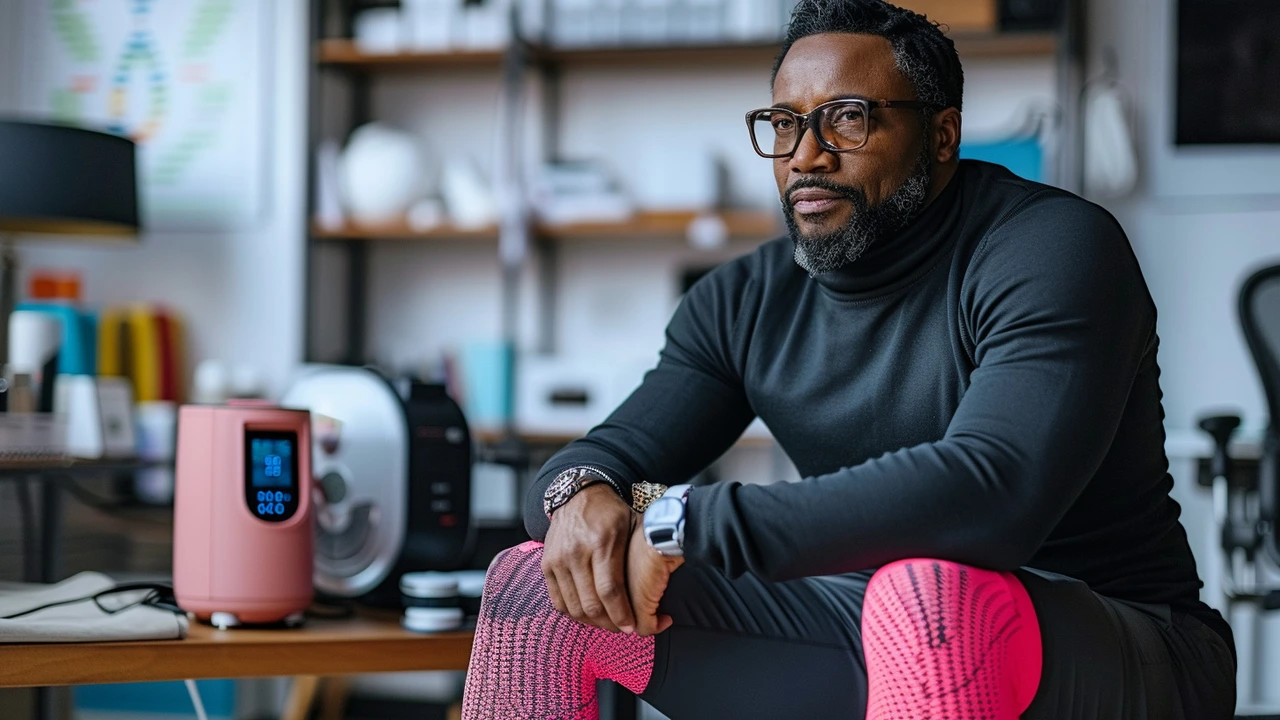Trigger Point Massage: Game Changer for Pain Management

Ever had a tight spot in your shoulder that just won’t quit, no matter how much you stretch or rub it? Welcome to the world of trigger points. These are those hard, painful knots in your muscles that can make even simple movements a pain.
Trigger point massage goes right for the source. Instead of just gliding over your skin, this technique finds the exact tender spot—the one you almost jump out of your seat when someone pokes it—and puts steady pressure on it. You get quicker, clearer results than you might from a regular Swedish massage.
If you’ve ever rolled on a tennis ball or begged a friend to “dig deeper” into a stubborn knot, you’ve already had a taste of trigger point work. But did you know that leaving these spots untreated can mess up your whole posture and even cause pain in totally different body parts? Some studies have shown a single trigger point in your neck or back can set off headaches that feel like migraines.
Understanding how to notice, treat, and prevent these trigger points can make daily life a lot less uncomfortable. Curious about how to start? There are simple moves and tools you can use at home, and I’ll walk you through them next. No need to be a pro—I’ll show you tricks anyone can use to break up muscle knots and stop chasing pain in circles.
- What Are Trigger Points?
- How Trigger Point Massage Works
- Why Traditional Massages Sometimes Miss the Mark
- Home Techniques for Finding and Treating Trigger Points
- When to See a Pro
- Tips for Lasting Pain Relief
What Are Trigger Points?
Trigger points are those sore knots in your muscles that hurt when pressed. They're basically spots where the muscle gets stuck in a tight contraction and doesn't let go. Think of them like little muscle roadblocks. That tight, tender spot often shoots pain to other areas—this is called referred pain, and it's why a knot in your back can make your arm or neck ache.
There are two types you’ll hear about most often:
- Active trigger points: These cause pain even when you’re just sitting around. Pressing them can make you twitch, wince, or even jump.
- Latent trigger points: These are hiding out. You might not feel them unless someone presses right on them, but they can still mess with your muscle strength and flexibility.
Trigger points often show up because of things like stress, bad posture, a quick injury, or doing the same motion over and over (like sitting at your desk slouched or texting with your neck bent!). They can happen in almost any muscle, but you’ll mostly find them in the shoulders, neck, back, hips, and even your jaw.
What’s really wild? Research says almost everyone has trigger points—especially adults who work at computers or have had an injury. In fact, in one table below, check out how common trigger points are for different body areas:
| Body Area | Percent with Trigger Points |
|---|---|
| Upper Back/Shoulder | 60% |
| Neck | 55% |
| Lower Back | 42% |
| Jaw/Face | 25% |
The real problem with trigger points is they don't just go away on their own. You can stretch, rest, and even ice the muscle, but the knot might stick around unless you target it directly. That’s exactly where trigger point massage comes in. When you learn how to spot these knots early, you can stop pain before it spreads and turns into something that drags on for months.
How Trigger Point Massage Works
Trigger point massage isn’t about relaxing the whole body at once—it’s about zeroing in on those tight, tender knots and releasing them. Here’s the deal: when you press on a trigger point, you’re actually resetting how that knot communicates with your nerves. If you apply the right amount of steady, direct pressure for 30 seconds to 2 minutes, that spot starts to "let go." Most people feel a mix of tenderness and good pain, and then—if you stick with it—a real sense of release. That's what turns the tides in trigger point massage.
Instead of big sweeping moves, this approach uses slow, focused pressure. Picture using a thumb, elbow, or a massage tool to press into the knot. You might feel the pain radiate, even into areas far from where you’re working. This is called referred pain, and it's a classic sign you’ve hit the right spot. Therapists often use the 1-to-10 pain scale (aim for 6 or 7—not tears, just enough discomfort to know you’re on target).
Want to know if it really works? A simple study out of New York found that adults with chronic shoulder pain cut their pain level nearly in half after only three sessions with targeted trigger point work. That’s huge compared to regular massage, which usually eases pain more gradually.
| Technique | Typical Duration | Main Tools Used | Pain Scale Target |
|---|---|---|---|
| Direct Compression | 30 sec – 2 min per point | Thumb, elbow, massage ball | 6-7/10 |
| Static Stretch | After release | Hands, towel, band | Gentle |
| Dry Needling* | 5-10 min total | Thin needles | Short, sharp |
*Dry needling is a professional treatment, not done at home.
The best part? A lot of people can learn the basics and do self-massage at home safely. Just start with your fingertips, a lacrosse ball, or even a foam roller. But more than anything, listen to your body—if you feel numbness or sharp pain, that’s a sign to stop.
Why Traditional Massages Sometimes Miss the Mark
Ever walked out of a regular massage feeling relaxed but still kind of annoyed because that deep knot in your shoulder won’t let up? That’s not just your imagination. Most traditional massages, like Swedish or relaxation massages, focus on smoothing out muscles and making you feel good overall. They don’t zero in on the real problem: the trigger points that actually cause the worst aches and pains.
Here’s the catch: triggers can be stubborn. They can hide deep inside muscle tissue, and unless you press right on them, they’ll stick around. Swedish massages use a lot of long, gentle strokes—nice for stress, but too light for breaking up deep tension. If you need real pain relief, it takes more than just surface-level rubbing.
According to the American Massage Therapy Association, about 80% of people who get massages report some short-term comfort, but only around 30% see their chronic pain fade after traditional sessions. Why? Because knots need targeted, direct pressure to release.
| Type of Massage | Main Focus | Effect on Muscle Knots |
|---|---|---|
| Swedish Massage | Relaxation, stress relief | Light—often doesn’t break up knots |
| Deep Tissue | General muscle tension | Better, but can still miss trigger points |
| Trigger Point Massage | Specific muscle knots | Targets and releases trigger points |
Deep tissue massage is a step up, sure, but even that can miss the mark if the therapist isn’t trained to hunt down and work those exact knots. It’s kind of like trying to fix a leaky faucet by just wiping up the water—you need to actually find the leak and fix it.
When a therapist skips over your trouble spot, or just uses general techniques, that’s when you leave with temporary relief but the same nagging pain. If you’re fed up with dull, lingering aches, a targeted approach makes all the difference. Spotting and treating trigger points is a total game changer for lasting results.

Home Techniques for Finding and Treating Trigger Points
Finding trigger points on your own isn’t tough—you just need a sense of where to look and how to press. Most trigger points hide out near the shoulders, neck, lower back, and hips. They often feel like hard lumps or tight bands in your muscles, and they usually hurt when you push on them. Some people even feel pain in a totally different spot. That’s normal; these are called referred pain patterns.
Here’s a simple way to spot trigger points at home:
- Use your fingers and slowly press along your muscles. When you hit a tender or knotty spot that hurts more than the area around it, you’ve probably found a trigger point.
- Compare both sides. Muscles on your left and right should usually feel similar. If one side has a knot and the other doesn’t, you’ve found something worth working on.
Once you’ve found a trigger point, here’s what to do next:
- Press and hold the sore spot with steady but comfortable pressure for 30-90 seconds. You can use your thumb, a tennis ball, or a massage tool. Don’t dig in so hard that it makes you tense up—think firm but not brutal.
- Keep breathing. If you tense your body, it’s too much.
- When you feel the pain or tightness ease up, gently rub the area or move that part of your body through its natural range of motion.
Don’t spend more than a couple minutes on one spot before moving on. Muscles need a break to reset.
You can do this kind of self-massage a few times a week. If you notice bruising or increased pain that lasts more than a day, ease up or check in with a pro. Stay hydrated and stretch lightly after working on your trigger points, since water helps flush out built-up waste products from your muscles.
For folks who love numbers, here’s a quick look at where people most often get trigger points and the most-used self-care tools:
| Muscle Area | Percent Reporting Trigger Points | Most Common Tool Used |
|---|---|---|
| Shoulders/Neck | 68% | Tennis Ball |
| Lower Back | 54% | Foam Roller |
| Hips/Glutes | 47% | Lacrosse Ball |
If your trigger point won’t budge or it keeps coming back, don’t wait too long to ask for help. Persistent pain isn’t something you have to just live with.
One last note: trigger point massage is all about improving quality of life, not toughing out more pain. Listen to your body—if it feels better, you’re doing it right.
When to See a Pro
Trying to tackle trigger points on your own works for a lot of people, but sometimes the usual tennis ball trick just isn’t enough. If you’ve been pressing or rolling on a painful knot for more than a week with no change, it’s probably time to check in with someone who does this for a living. When you keep getting the same nagging pain, or the spot just seems to fight back, a trained therapist can make a big difference.
Here are some specific reasons to book an appointment with a pro:
- The pain shoots beyond the knot, like into your arm or leg—this is called referred pain and it needs more expertise.
- You’re losing movement or range—if you suddenly can’t turn your head or lift your arm, don’t wait it out.
- Self-massage hurts more than helps, or you end up with new soreness that lasts for days.
- You have a history of injuries, especially in your back, neck, or joints. Specialized techniques might be safer for you.
- Headaches or numbness keep popping up along with the muscle pain—these can be signs of something a bit more complicated.
Pro therapists can do trigger point injections, dry needling, or use advanced tools and knowledge you just won’t have at home. Sometimes, even doctors refer patients for trigger point treatment—especially for pain management after injuries or surgeries when medication simply isn’t enough.
According to the American Massage Therapy Association, “Working with a licensed massage therapist can help identify underlying patterns and prevent chronic pain from becoming a bigger problem.”
“Seeking professional help ensures you’re treating the right spots, using the safest methods, and getting the long-term relief you deserve.” — American Massage Therapy Association
If your pain is stubborn, spreading, or starting to mess with your daily life, make seeing a pro your next move. They’ll guide you with a plan that fits your body, not just quick fixes.
Tips for Lasting Pain Relief
Let’s be honest—nobody wants to be stuck in a never-ending cycle of pain and quick fixes. If you want trigger point massage to work for you long-term, you’ll need a few extra tricks up your sleeve. Here’s how you can go beyond just tackling muscle knots when they pop up, and really lower your odds of pain coming back.
Trigger point massage is not a one-and-done miracle. Body habits, stress, and posture play massive roles in how and why those knots show up. Target the root and you get way more relief.
- Stay active but balanced. People who move regularly show lower muscle sensitivity and less trigger point recurrence. Try mixing up walking, stretching, and gentle strength training instead of sticking to just one routine.
- Hydrate—seriously. Dehydrated muscles get cranky. Even mild dehydration can make soreness stick around about 20% longer. Aim for about half your body weight in ounces of water per day for decent muscle recovery.
- Fix your desk setup. If you’re hunched at a screen all day, you’re inviting trigger points. Keep your screen at eye level and your shoulders relaxed. A simple back support or pillow can make a huge difference.
- Self-massage tools help. Foam rollers and massage balls can keep knots from coming back between professional sessions. Ten minutes a few times a week can lower muscle tension by up to 30% according to some clinic studies.
- Sleep matters more than you think. Adults sleeping less than six hours a night tend to report more frequent and painful trigger points. Good sleep lets your body heal—not just your brain.
If you’re curious about what actually changes when you stay on top of trigger points, check out these stats based on clinical research:
| Habit | Reduction in Pain Recurrence | Extra Benefit |
|---|---|---|
| Regular stretching | 40% | Improved flexibility |
| Hydration | 20-25% | Fewer cramps |
| Good sleep (7-8 hrs/night) | 35% | Better mood |
| Weekly foam rolling | 30% | Faster muscle recovery |
The big takeaway? Sticking with these habits is way more powerful than chasing pain once it starts. A little tweaking to your daily routine pays off big time, keeping muscle aches from running your life. So, next time you feel a knot, think about how you can stop it from showing up in the first place.





